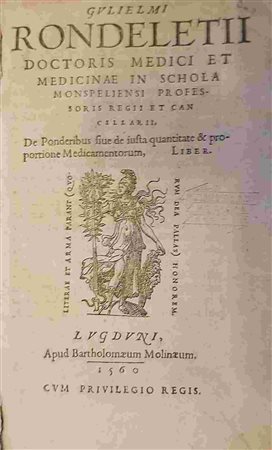 Bertolami Fine Art - Sendlinger Straße 24, 80331 Monaco
Bertolami Fine Art - Sendlinger Straße 24, 80331 Monaco
WEB AUCTION 118 - LIBRI E AUTOGRAFI WEB AUCTION 118 - LIBRI E AUTOGRAFI
giovedì 16 giugno 2022 ore 14:00 (UTC +01:00)
GUILLAUME RONDELET (1507-1566) : Gulielmi Rondeletii ... De Ponderibus sive de justa quantitate & proportione medicamentorum, Liber. Lugduni (Lyon) Apud Bartholomaeum Molinaeum, 1560
GUILLAUME RONDELET (1507-1566)
Gulielmi Rondeletii ... De Ponderibus sive de justa quantitate & proportione medicamentorum, Liber. Lugduni (Lyon) Apud Bartholomaeum Molinaeum, 1560
§ 8° (163 x 102 ), ( 24, 168, 58 pp.), contemporary limp vellum (remounted ) with remnants of clasps, flyleaves renewed, author’s portrait into oval frame. woodcut head and tail-pieces, printed typhographical notes on margins, scattered minimal brownig, fine copy.
The utmost are first edition. Rondelet, physician and naturalist, is best known for his work on aquatic life (Libri de piscibus marinis and Universae aquatilium historiae), which described about 250 species, far more than any earlier work in that field and, despite its theoretical limitation, laid the foundations for later ichthyological research, remaining the standard reference work for over a century. Rondelet was regius professor at the university of Montpellier and personal physician to François Cardinal Tournon; in 1556, he was elected chancellor and at his initiative the university set up its first anatomy theater: “in 1556, Henri II, urged by Rondelet, had an anatomical amphitheater built in the faculty of Montpellier, where Rondelet was elected chancellor in November of the same year.” (Hoefer, 599, translated). Rondelet has also written several medical books; in the present work he deals with the problem of establishing de iusta quantitate & proportione (the right quantity and proportion) of the different types of drugs to be used and which factors must be taken into consideration. He first describes the difficulties of the task, the reasons that can influence the effectiveness of the remedies depending on the quantity administered, the criteria to be followed to make a decision, when to increase or decrease the prescribed doses; he then describes several remedies and for each one suggests how to calculate the correct dose to obtain the desired result.
Ref: Hoefer, XLII, 599-600;




